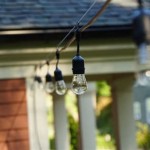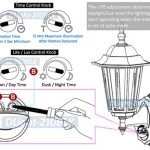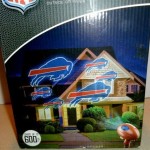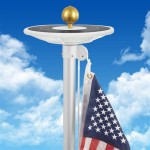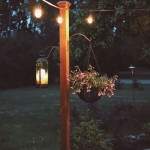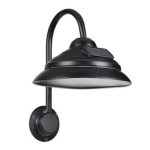Most Powerful Outdoor Lights: Illuminating Your Surroundings
Outdoor lighting serves multiple purposes, ranging from enhancing security and safety to creating ambiance for outdoor gatherings. Selecting the most powerful outdoor lights requires careful consideration of factors such as lumen output, beam angle, light source technology, and intended application. The following article explores these aspects to guide informed decisions when seeking high-performance outdoor illumination.
Understanding Lumens and Lux
Lumens represent the total amount of visible light emitted by a light source. A higher lumen value indicates a brighter light. Lux, on the other hand, measures the illuminance on a surface area, specifically the number of lumens per square meter. When choosing outdoor lights, focusing solely on lumen output can be misleading. The effectiveness of the light also depends on how the light is distributed, which is influenced by the beam angle and reflector design.
For instance, a high-lumen floodlight with a wide beam angle will disperse light over a larger area, resulting in lower lux values at any specific point within that area. Conversely, a spotlight with the same lumen output but a narrow beam angle will concentrate the light, producing higher lux values in a smaller area. Therefore, the desired application should dictate the balance between lumen output and beam angle. Security lighting often benefits from higher lumen output concentrated in specific areas, while pathway lighting may require lower lumen output spread more evenly.
The perceived brightness of a light source is also subjective and influenced by environmental factors. Ambient light pollution can diminish the effectiveness of even high-lumen outdoor lights. In areas with significant ambient light, selecting lights with higher lumen output becomes increasingly important. Reflective surfaces, such as light-colored walls or pavement, can enhance the perceived brightness, while dark, absorbent surfaces will reduce it.
Consideration should also be given to the color temperature of the light. Measured in Kelvin (K), color temperature affects the perceived warmth or coolness of the light. Lower Kelvin values (e.g., 2700K-3000K) produce a warm, yellowish light that is generally considered more inviting and less harsh. Higher Kelvin values (e.g., 5000K-6500K) produce a cool, bluish-white light that is often preferred for security applications due to its perceived brightness and ability to render colors more accurately. The choice of color temperature should align with the intended purpose and aesthetic preferences.
Exploring Light Source Technologies: LED, Halogen, and More
Several light source technologies are available for outdoor lighting, each with its own advantages and disadvantages. Light-Emitting Diodes (LEDs) have become the dominant technology due to their energy efficiency, long lifespan, and durability. Halogen lights, while less efficient than LEDs, offer a bright, white light at a lower initial cost. The specific requirements of the application will often determine the optimal choice of light source technology.
LEDs are known for their significantly longer lifespan compared to traditional incandescent or halogen bulbs. A typical LED outdoor light can last for tens of thousands of hours, reducing the need for frequent replacements and minimizing maintenance costs. Their energy efficiency also translates to lower electricity bills, making them a cost-effective option in the long run. Furthermore, LEDs are relatively resistant to vibration and impact, making them suitable for outdoor environments where they may be exposed to the elements.
Halogen lamps, while offering a bright light output, consume considerably more energy than LEDs and have a shorter lifespan. They also generate more heat, which can be a concern in certain applications. While their initial cost is often lower, the higher energy consumption and shorter lifespan can result in higher overall costs over time. The intense heat generated by halogen lamps can also be a safety hazard if not properly shielded or installed.
Metal halide lamps are another option for high-intensity outdoor lighting, often used in commercial or industrial settings where extremely high lumen output is required. They offer a high lumen-per-watt ratio and a long lifespan, but they also require a ballast to regulate the current, adding to the overall cost and complexity of the system. Metal halide lamps also require a warm-up period before reaching full brightness, which can be a drawback in security applications where instant illumination is needed.
Selecting the appropriate light source technology involves a trade-off between initial cost, energy efficiency, lifespan, and light quality. LEDs generally offer the best balance of these factors for most outdoor lighting applications, but the specific requirements of the project should be carefully considered when making a decision.
Key Applications and Light Selection
Outdoor lighting requirements vary significantly depending on the intended application. Security lighting, pathway lighting, floodlighting, and landscape lighting each have distinct needs in terms of lumen output, beam angle, and placement. Tailoring the light selection to the specific application is crucial for achieving optimal performance.
Security lighting aims to deter intruders and enhance visibility around the perimeter of a property. High-lumen floodlights with motion sensors are often used to illuminate large areas, while spotlights can be strategically placed to highlight vulnerable points such as doorways and windows. A cool, bright light (e.g., 5000K-6500K) is generally preferred for security lighting due to its perceived brightness and ability to enhance color rendering. Motion sensors are an important feature for security lights as they provide lighting when needed and save energy when there is no activity.
Pathway lighting focuses on providing safe and well-defined routes for pedestrians. Low-level lights with a soft, diffused light are typically used to illuminate walkways and driveways. A warm, inviting light (e.g., 2700K-3000K) is often preferred for pathway lighting to create a welcoming atmosphere. The spacing and placement of pathway lights should ensure consistent illumination without creating glare or shadows.
Floodlighting is used to illuminate large areas, such as parking lots or sports fields. High-lumen floodlights with a wide beam angle are required to provide uniform illumination across the entire area. The height and placement of the floodlights should be carefully considered to minimize glare and light trespass onto neighboring properties. The optimal choice of light source technology will depend on the size of the area and the desired light level.
Landscape lighting aims to enhance the aesthetic appeal of outdoor spaces by highlighting architectural features, plants, and garden elements. Low-voltage landscape lights are often used to create subtle and dramatic effects. Spotlights can be used to uplight trees or sculptures, while downlights can be used to create pools of light on patios or decks. The color temperature of the landscape lights should be carefully chosen to complement the surrounding environment.
In addition to the specific application, regulatory requirements and environmental considerations should also be taken into account. Many municipalities have ordinances that limit the amount of light trespass onto neighboring properties. Choosing lights with appropriate shielding and beam control can help to minimize light pollution and comply with local regulations. Opting for energy-efficient lighting technologies, such as LEDs, can also help to reduce the environmental impact of outdoor lighting.

10 Best Outdoor Lighting Ideas Landscape Design Secrets A Piece Of Rainbow

The Best Outdoor Lighting Ideas In 2024

5 Best Outdoor Solar Lights Of 2024 Reviewed

5 Best Outdoor Solar Lights Of 2024 Reviewed

The Definitive Guide To Best Outdoor Ground Lights 2024 Edition

The Best Outdoor Wall Lights Of 2024 Lighting Design

How To Choose The Best Outdoor String Lights

The 3 Best Smart Outdoor Lights For Backyards Of 2024 Reviews By Wirecutter

19 Stylish Outdoor Lighting Ideas The Best Patio

Best Outdoor Lighting Bulbs Of 2024
Related Posts

